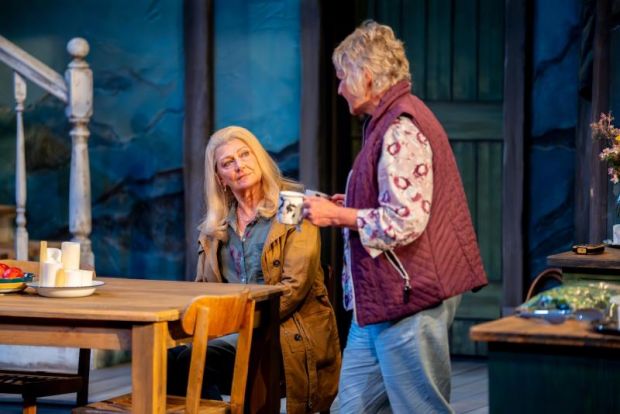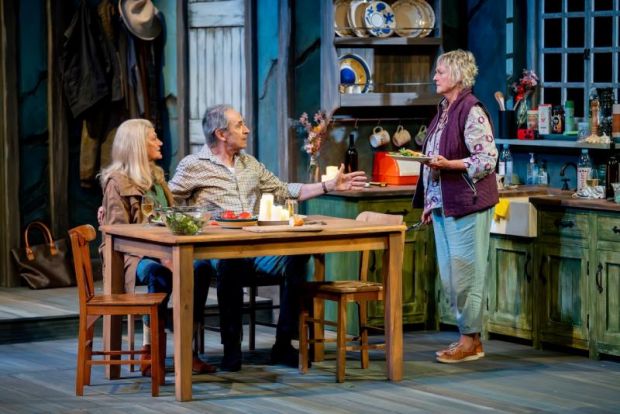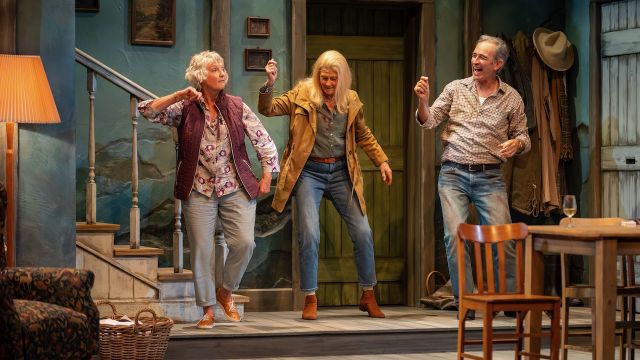The Children
‘I don’t know how to want less’ says Hazel in desperation, a child’s response to an adult question, when presented with choices in preservation. She’s a mother of four, grandmother to four more, who has spent her life trying to prolong her future: with sunscreen, yoga, and salads. Her husband Robin thinks too much of himself and drinks too much of his home-made wine. Rose was a co-worker to them both, an occasional lover to Robin, and has returned from self-exile in America with secrets to share.
Inspired by the tsunami-inducing incidents at Fukushima, with its three characters all unlikely retired nuclear scientists, you might expect the drama of the TV miniseries Chernobyl. But this is the soft coastal countryside of England - it starts almost as a sit-com with its opening scene of an accidental nosebleed.

Through its nearly-two-hour, one act staging, the story unravels many secrets from the pasts of the three, their dense dialogue wandering as much as the actors. Their prolific words define characters, gives them tremendous depth – though with a lot of loose ends that don’t always need tying up.
The play by Lucy Kirkwood originally opened in the West End in 2016, and then on Broadway a year later, where it was graced with two Tony Award nominations. A Sydney/Melbourne production in 2018 was awarded three Helpmanns for directing, acting, and best play, and this new State Theatre revival has a short, pre-Festival season in Adelaide’s Dunstan Playhouse.

Tina Bursill is a powerhouse as an enigmatic Rose, doggedly avoiding the awkward questions by asking her own. Bursill keeps us on the edge of our uncomfortable seats, waiting for her next shocking story from her past, or wondering where she’s going with her orthogonal conversation-starters. Her interactions with Genevieve Mooy’s Hazel are marvellous, their distinct personalities tightening Hazel’s spring as Rose’s unwinds. And whilst Mooy seems initially uneasy in her outer shell of a ‘perfect’ grandmother who wants to live forever, her frustrations at why Rose is visiting after nearly four decades are wonderfully surfaced between the ever-increasing cracks in her optimistic mask. Bursill and Mooy’s characters are at extreme opposites – Rose’s long-flowing blonde hair could not be more different than the practical, uncoloured cut of Hazel; whilst her household remedies for removing a stain on Rose’s clothes contrasts with the latter’s literal throwaway choice.
Terence Crawford brings energy to the stage as Robin when he bursts in from ‘tending to the cows’. Together with Hazel, they now live in a small cottage with bad plumbing and intermittent electricity – not far from their previous house, which sits on the boundary of the exclusion zone from a recent unnatural disaster at the local nuclear power station. Crawford alternates his sarcasm and sorrow, shows excellent comedy whilst trying to polish tales of Robin’s past philandering, and surprises us with smooth dance moves. He makes this complex Robin almost sympathetic despite his ego, sexism, and emotional undermining.

Victoria Lamb’s set design is a statement full of detail – there’s so much to look at: you want to explore the stage afterwards to look at the pictures on the wall and sit in the comfy-looking armchair. For the most part, Nic Mollison’s lighting doesn’t have much to do, but it’s brilliant when it gets the chance to bring the sunlight inside. Andrew Howard’s sound design underscores the action, and director Corey McMahon’s positioning of his performers gives extra depth to each character – how they stand at the sink, sit in the armchair, or take a drink, whilst allowing them to tell their stories.
It’s wonderful to see the stage entirely populated with older actors having challenging dialogue and movement, and having the narrative deal with the consequences of choices made, rather than the opportunities of the future. And yet, it still questions what is to come, posing uncomfortable questions about the roles and responsibilities of an ageing population. However, it is sometimes ponderous and the dialogue’s intricate characterisation can confuse and obscure the messages – the result is that the play is not quite as poignant as it thinks it is.

Despite its post-bucolic setting, and references specific to British television, it just about works here in Australia – perhaps because we’re increasingly familiar with floods, fires, and other massive events that uproot our own communities. Maybe there is also a universal anxiety of realising the impact of our past actions on the world, and a common desperation of trying to find a place in it now. Those themes are not unique to the baby-boomer generation, but what Kirkwood achieves with The Children is bringing together three individuals who initially have very different ideas about how to spend their final years. Facing the disasters they helped to create – both at global and personal levels – nudges the audience to understand that the enormity of these situations can be overcome, and that each person still has their part to play.
Mark Wickett
Photographer: Matt Byrne
Subscribe to our E-Newsletter, buy our latest print edition or find a Performing Arts book at Book Nook.

